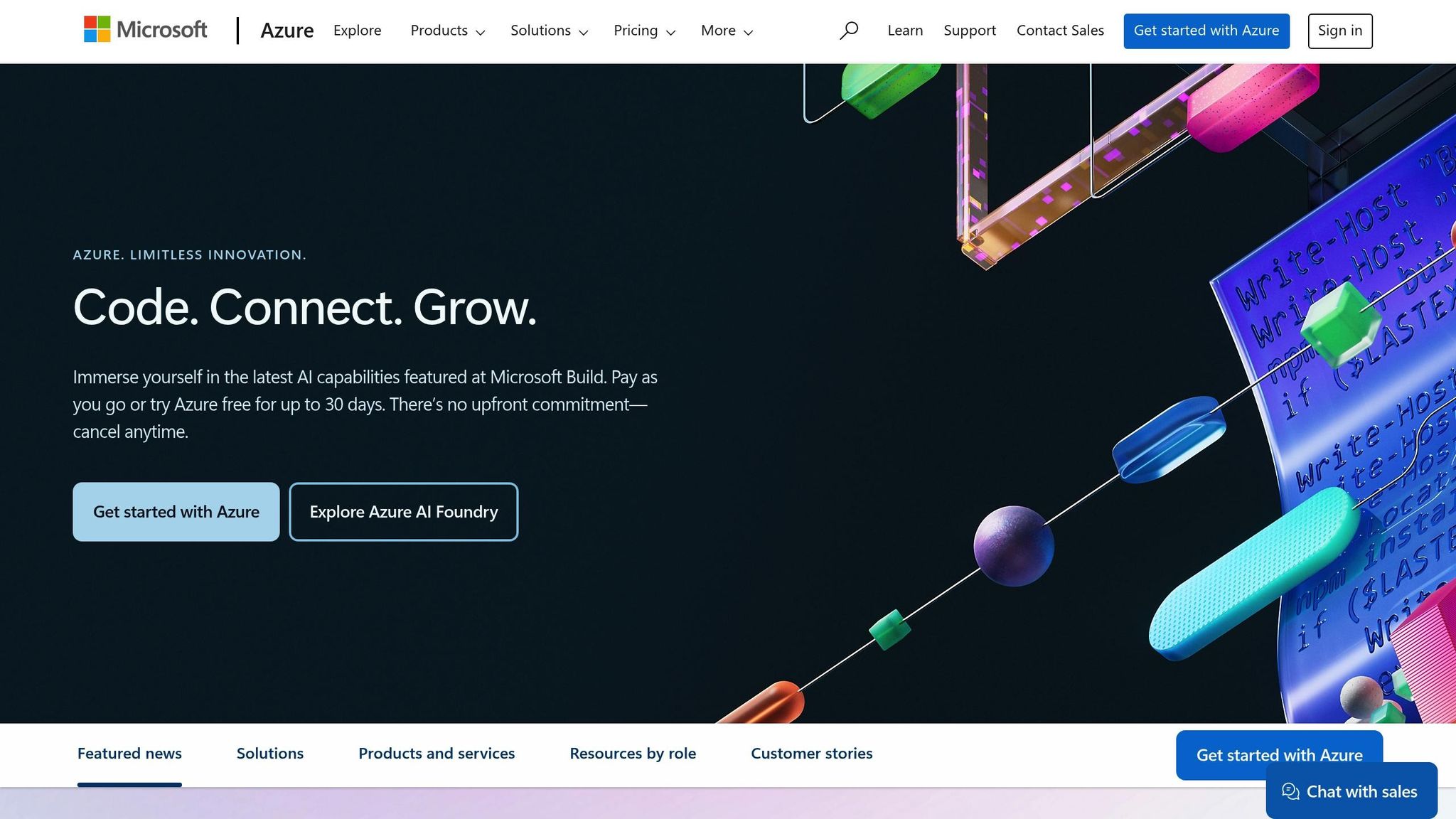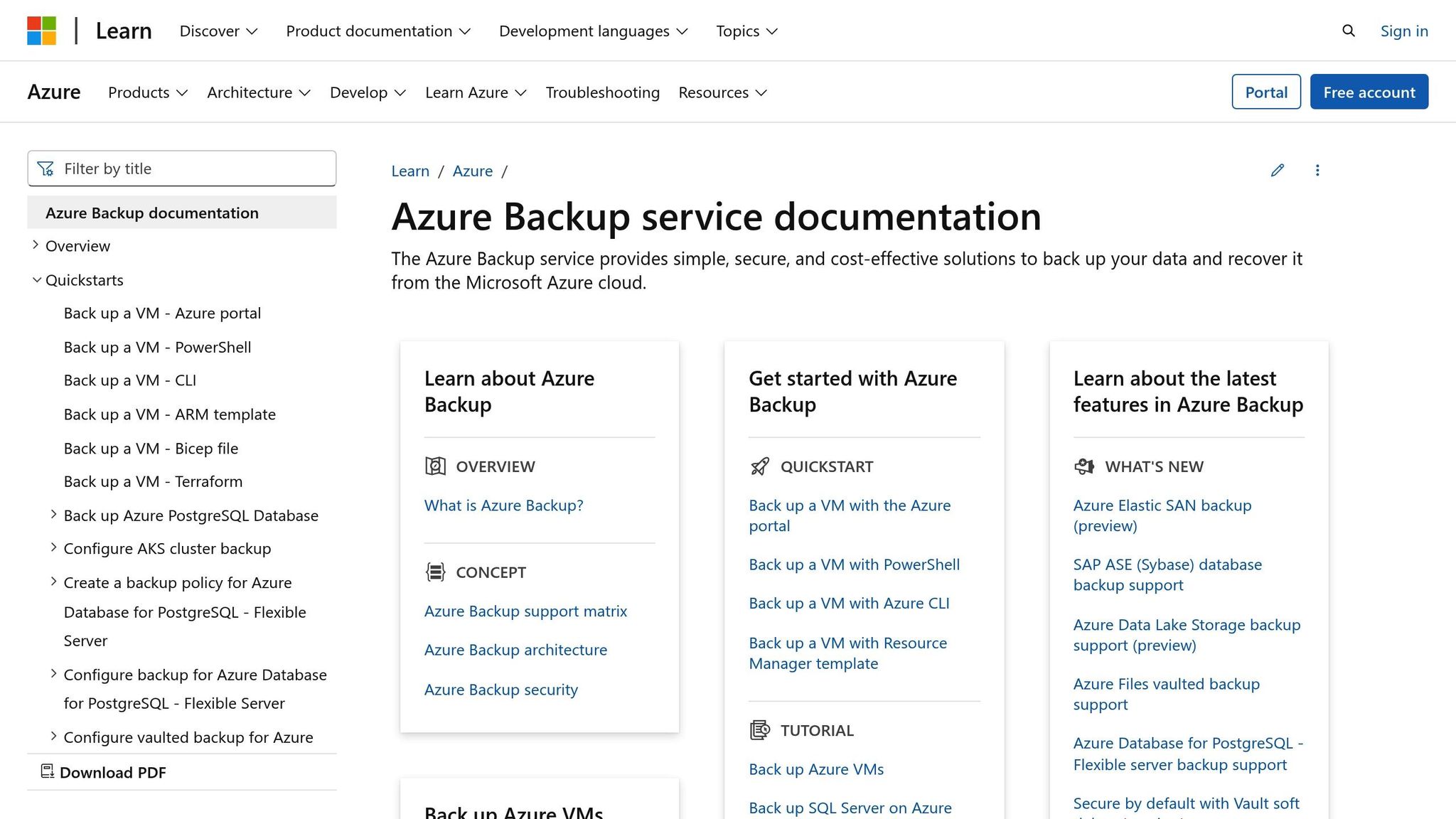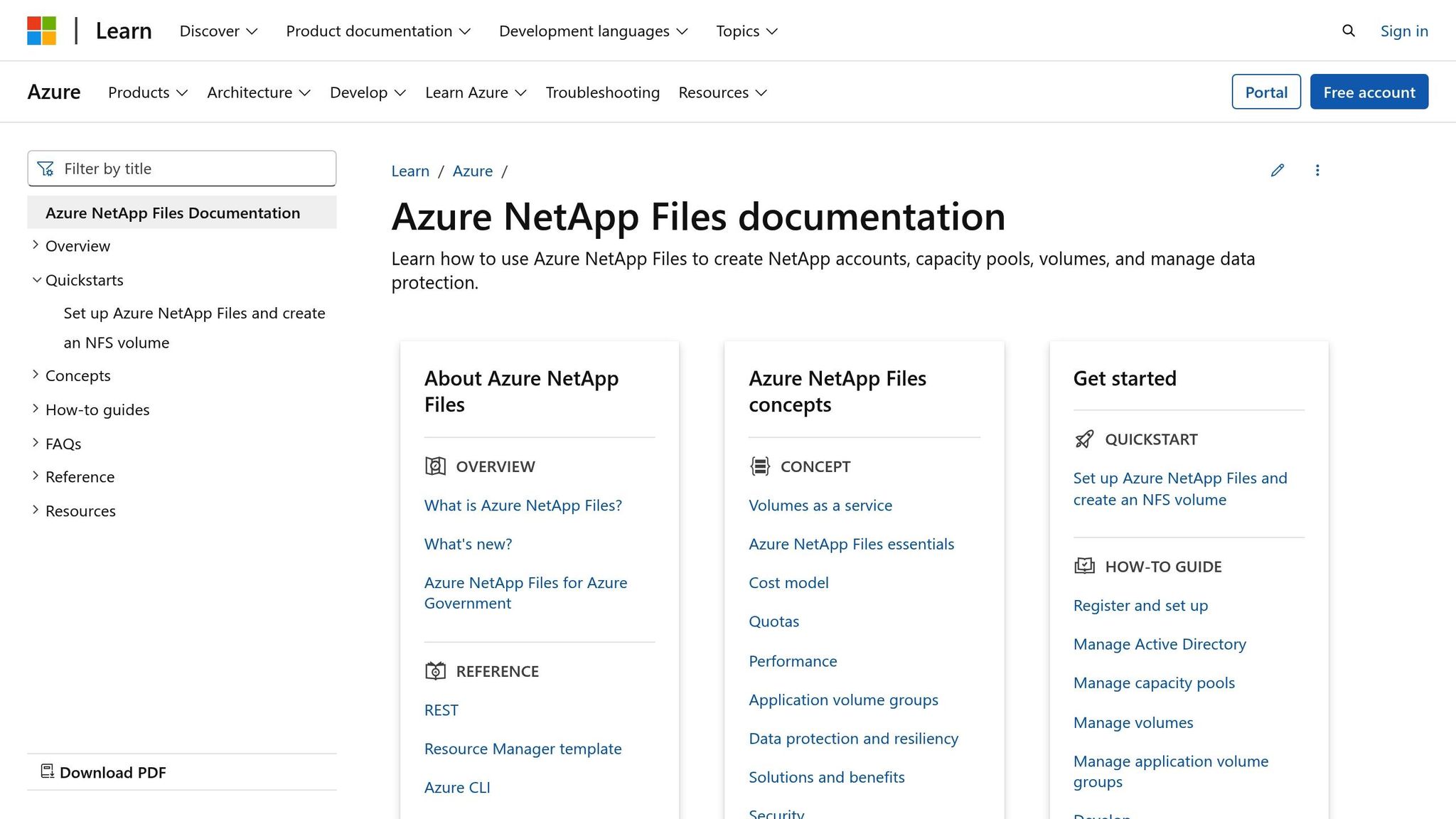Azure Resiliency Patterns for SMB Applications
Explore effective Azure resiliency patterns tailored for SMB applications, ensuring high availability and cost-efficient solutions.

Azure offers powerful tools to help small and medium-sized businesses (SMBs) keep their applications running smoothly, even during failures or disruptions. Here's a quick breakdown:
-
Key Resiliency Patterns:
- Active-Active vs Active-Passive: Active-Active setups minimise downtime with near-zero recovery time but cost more. Active-Passive is cheaper but slower to recover.
- Auto-Scaling & Load Balancing: Automatically adjusts resources based on demand to maintain performance without manual intervention.
- Availability Zones: Physically separate datacentres in a region ensure high availability and low latency.
-
Storage Resiliency:
- Use Premium Storage (faster but costlier) for critical tasks and Standard Storage for backups or less demanding needs.
- Choose the right redundancy option: LRS (local), ZRS (zone), or GRS (geo-redundant) based on your business needs and budget.
-
Backup & Recovery:
- Implement Azure Backup and Site Recovery for disaster recovery and data protection.
- Use features like soft delete and automated failover to minimise data loss.
-
Cost Management Tips:
- Use tools like Azure Advisor and Cost Management to optimise spending.
- Leverage Azure Hybrid Benefit to save on Windows Server and SQL Server licences.
Quick Comparison Table
| Feature | Cost | Recovery Time (RTO) | Complexity | Best Use Case |
|---|---|---|---|---|
| Active-Active | High | Near-zero | High | High-traffic applications |
| Active-Passive | Low | Higher | Low | Cost-conscious setups |
| Premium Storage | High (£) | Low latency | Medium | Databases, critical tasks |
| Standard Storage | Low (£) | Higher latency | Low | Backups, file sharing |
| LRS/ZRS/GRS Storage | Varies (£) | Varies | Medium | Data redundancy needs |
Architecting highly resilient applications in Azure: A technical guide for developers | BRK197

Core Azure Resiliency Patterns for SMB Applications
To ensure uninterrupted operations, small and medium-sized businesses (SMBs) need to adopt effective resiliency strategies. Azure offers a range of approaches designed to safeguard operations and maintain service availability. These strategies align with previously discussed availability targets and provide a solid foundation for resilience.
Active-Active and Active-Passive Setups
The choice between active-active and active-passive configurations plays a critical role in how quickly your business can recover from failures.
In an active-active setup, all nodes operate simultaneously, sharing the workload and providing immediate failover capabilities. If one component fails, the remaining nodes seamlessly take over, ensuring uninterrupted service.
On the other hand, an active-passive setup keeps standby systems on hand, ready to take over only when the primary system encounters an issue. This approach is particularly suited for disaster recovery scenarios where controlling costs is a priority.
Here's a quick comparison of the two configurations:
| Configuration | Operating Costs | Recovery Time | Management Complexity | Risk of Full Outage |
|---|---|---|---|---|
| Active-Active | Higher | Near-zero RTO | More complex | Lower |
| Active-Passive | Lower | Higher RTO | Easier to manage | Higher likelihood |
For businesses handling heavy traffic or operating under strict SLAs, active-active is the better option. Meanwhile, active-passive is a practical choice for cost-conscious environments.
Auto-Scaling and Load Balancing
Azure Load Balancer is a cornerstone of resilient application design. It distributes network traffic across multiple servers, ensuring both high performance and availability. With its ability to automatically scale based on traffic demand, it eliminates the need for manual adjustments and supports both public and internal load balancing, making it flexible for various SMB use cases.
To optimise performance, you can:
- Configure load balancing rules and backend pools.
- Monitor key metrics like latency, throughput, and error rates.
- Set idle connection timeouts and implement session persistence when needed.
Key metrics such as data path availability, health probe status, and traffic distribution should be regularly reviewed to identify and address potential problems. For added security and performance, consider distributing virtual machines across multiple availability zones, using Network Security Groups to manage traffic flow, and integrating Azure DDoS Protection.
These load balancing strategies integrate seamlessly with Azure's geographic redundancy features, which are explored in the next section.
Azure Availability Zones and Regions
Azure Availability Zones offer another layer of fault tolerance by providing physically separated datacentres within the same region. Each zone operates with independent power, cooling, and networking, ensuring that issues in one zone don’t affect others. This setup maintains service availability even during significant infrastructure disruptions. With latencies of under two milliseconds between zones, applications can run efficiently across multiple locations.
Zone-redundant services (ZRS) further enhance resilience by replicating data across zones, reducing the risk of single points of failure. For example, managed disks typically achieve 99.999% availability and at least 99.999999999% (11 nines) durability, while ZRS disks offer an even higher durability of approximately 99.9999999999% (12 nines) over a year.
As Adobe's Mitch Nelson, Director of Managed Services, highlights:
"Availability zones give us the combination of low latency and high availability that we need to meet customer requirements. All of my team's applications with higher SLA levels are now built on availability zones. The physical separation of availability zones builds an extra layer of redundancy."
For SMBs, zone-redundant deployments provide a cost-effective way to maintain high availability. By starting with such deployments and incorporating asynchronous data backups to other regions, businesses can establish a resilient foundation. The key is to align deployment strategies with business needs, considering factors such as risk tolerance, recovery time objectives, SLA requirements, and budget constraints.
Storage Resiliency Strategies
When it comes to resilient design, data storage is at the heart of the conversation. For SMBs using Azure, choosing the right storage setup can be the difference between smooth operations and expensive downtime. Just as compute resiliency is crucial, your storage strategy also needs to balance reliability and cost-effectiveness.
Premium vs Standard Storage Options
Azure provides two main storage tiers. Premium Storage relies on SSDs to deliver ultra-low latency, often in the range of single-digit milliseconds. This makes it perfect for tasks like running databases, high-performance applications, or development environments where speed is non-negotiable. On the other hand, Standard Storage uses HDDs, offering a more budget-friendly option for general-purpose needs, such as file sharing or archiving, where speed isn't as critical.
Premium file shares use a provisioned billing model, meaning you pay for the storage capacity you allocate, regardless of how much you actually use. In contrast, Standard file shares follow a pay-as-you-go model, where you’re only charged for what you consume. Premium Storage also supports bursting capabilities, while Premium Managed Disks guarantee specific levels of IOPS and throughput 99.9% of the time.
| Feature | Premium Storage | Standard Storage |
|---|---|---|
| Storage Media | SSDs | HDDs |
| Latency | Single-digit milliseconds | Higher than Premium |
| Billing Model | Provisioned capacity | Pay-as-you-go |
| Use Cases | Databases, high-performance apps | File shares, backups |
| Redundancy Options | LRS, ZRS | LRS, GRS, RA-GRS, ZRS, GZRS, RA-GZRS |
For SMBs running customer-facing applications or handling time-sensitive data, Premium Storage's performance can justify the higher costs by minimising downtime and improving user experience. Meanwhile, Standard Storage is ideal for backups, team file shares, or applications with less demanding performance needs. Once you’ve chosen the right storage tier, the next step is ensuring data resilience through replication.
Data Replication Options
After selecting a storage tier, it’s critical to replicate your data to safeguard application continuity. Azure offers a range of redundancy options to match different levels of protection.
- Locally Redundant Storage (LRS): Replicates your data across multiple servers and racks within a single data centre.
- Zone-Redundant Storage (ZRS): Distributes data across multiple availability zones in one region for better availability.
- Geo-Redundant Storage (GRS): Copies data to a secondary region, providing up to 16 nines durability for disaster recovery.
- Read-Access GRS (RA-GRS): Extends GRS by allowing read access to the secondary region during primary region outages.
- Geo-Zone-Redundant Storage (GZRS): Combines the benefits of zone redundancy with cross-region replication, offering maximum availability.
"Choosing the appropriate redundancy model depends on your business continuity requirements, data criticality, and budget considerations."
You can also optimise costs by implementing lifecycle management policies, which automatically shift data between storage tiers based on usage patterns. Planning for future storage and performance needs ensures your setup stays reliable as your business scales.
Azure Backup and Recovery Solutions

Azure Backup provides a structured way to manage backups using Recovery Services and Backup vaults. This complements the high availability measures discussed earlier. A solid backup plan hinges on clear policies for scheduling (when backups occur) and retention (how long backups are stored). For mission-critical systems, scheduling frequent automated backups during off-peak hours can reduce the Recovery Point Objective (RPO) without affecting performance.
Azure Site Recovery (ASR) takes things a step further by allowing businesses to replicate workloads and virtual machines to Azure as part of a Disaster Recovery as a Service (DRaaS) solution. This ensures business continuity during major infrastructure failures. To avoid network congestion, stagger backup schedules across different virtual machines. Features like soft delete protection and role-based access control add an extra layer of security against accidental deletions.
For SMBs, cost management is just as important as reliability. Using the Archive Tier for long-term retention can significantly cut storage expenses, especially for compliance data. Meanwhile, features like Instant Restore speed up recovery, helping to lower the Recovery Time Objective (RTO). Regularly testing your restoration processes, automating failover and failback, and monitoring everything through Azure Monitor can further improve backup reliability.
"Over a year into the pandemic, digital adoption curves aren't slowing down. They're accelerating, and it's just the beginning. We are building the cloud for the next decade, expanding our addressable market and innovating across every layer of the tech stack to help our customers be resilient and transform."
This underscores the importance of crafting storage strategies that not only meet current needs but are flexible enough to evolve with your business. For SMBs, balancing cost and performance is key to staying resilient in an ever-changing digital landscape.
For more insights on managing Azure costs and deployments, check out Azure Optimization Tips, Costs & Best Practices.
Resiliency During Planned Maintenance and Upgrades
Azure maintenance updates don't have to disrupt your SMB applications. With the right preparation, your systems can continue running smoothly while Azure handles essential upgrades in the background.
Preparing Applications for Maintenance Events
Azure employs strategies to minimise disruptions during maintenance. For example, it may briefly pause virtual machines or live-migrate them to different hardware to ensure services remain available. If a reboot is unavoidable, Microsoft provides advance notice and allows you to schedule these updates during off-peak hours through self-maintenance windows.
To keep your applications informed, Azure's Scheduled Events feature sends real-time notifications to your virtual machines about upcoming maintenance. This gives your systems time to wrap up ongoing tasks, save their state, or redirect traffic as needed. Since maintenance windows are provided in UTC, ensure you adjust for your local time zone when planning.
Building retry logic into your applications is another critical step. Many Azure services and client SDKs come with configurable retry mechanisms, and libraries are available to implement this feature. For added flexibility, service meshes can also enhance resiliency without requiring changes to your application code.
Timeout settings are equally important. They prevent applications from freezing during brief service interruptions and work hand-in-hand with retry logic. Most maintenance-related pauses last less than 30 seconds, but some systems may require timeouts of up to 45 seconds. Distributing workloads across Azure's Availability Zones, as previously discussed, adds another layer of protection, while Azure's health monitoring services can detect issues and initiate failover procedures automatically.
For applications that rely on file shares, specialised measures can further ensure resilience during maintenance.
Azure NetApp Files for SMB Continuous Availability

For SMBs that depend on file shares, Azure NetApp Files provides a reliable way to maintain uninterrupted access during maintenance. This service includes transparent failover capabilities, particularly useful for applications that can't afford connectivity interruptions.
Azure NetApp Files undergoes periodic maintenance for platform updates, but these operations are designed to be non-disruptive from a file protocol perspective. The service supports SMB Transparent Failover, allowing maintenance tasks to proceed without disconnecting server applications that store and access data on SMB volumes.
Specific workloads, such as Citrix App Layering, FSLogix user profile containers, FSLogix ODFC containers, Microsoft SQL Server (excluding Linux versions), and MSIX app attach, benefit from SMB Continuous Availability. These workloads experience seamless failover during maintenance, ensuring users aren't affected by service interruptions.
If you enable Continuous Availability for existing SMB shares, remember to reboot the Windows systems accessing these shares. This step ensures the enhanced availability features are recognised. Although brief I/O pauses may still occur during failover, applications should be configured to handle these interruptions gracefully. Azure NetApp Files manages the infrastructure-level failover, but your applications need to be designed with appropriate timeout settings to resume operations smoothly after connectivity is restored.
For applications not supported by SMB Continuous Availability, Azure NetApp Files still provides robust resilience. The key is understanding your application's tolerance for brief I/O interruptions and configuring timeout settings accordingly. While most modern applications can handle these pauses without issue, older systems may require additional adjustments to align with the service's capabilities.
Cost Management and Resiliency Best Practices
Small and medium-sized businesses (SMBs) can maintain fault tolerance while keeping costs under control by combining strategic planning with Azure's suite of services. Here's how to balance resilience and budget effectively.
Budget-Friendly Resiliency Design
Building resilient Azure applications doesn’t have to break the bank - tailoring solutions to actual needs is key. For instance, Azure Hybrid Benefit allows businesses to save significantly on existing Windows Server and SQL Server licences, offering savings of up to 36% for Windows Server customers and 28% for SQL Server customers compared to other cloud providers.
When it comes to storage, redundancy options play a big role in determining both costs and protection levels. Here's a quick breakdown:
| Redundancy Type | Cost Factor | Ideal For |
|---|---|---|
| Locally Redundant (LRS) | 1x (Base cost) | Non-critical workloads |
| Zone-Redundant (ZRS) | 1.5x | Regional resilience |
| Geo-Redundant (GRS) | 2x | Disaster recovery |
| Read-Access GRS (RA-GRS) | 2.5x | High availability |
For database resilience, the basic tier starts at about £0.0211 per DTU-hour, with secondary databases priced the same as the primary tier. Data transfers between UK regions are approximately £0.021 per GB, making it easier to predict costs with precision rather than relying on estimates.
Tools like Azure Advisor and Azure Cost Management help businesses track spending and identify savings opportunities. Azure Advisor reviews your usage patterns and offers specific recommendations, while Azure Cost Management provides budget alerts and detailed usage tracking. Pair these with the Microsoft Cloud Adoption Framework for Azure to establish governance practices that keep spending in check without sacrificing resilience.
When considering storage options, premium storage delivers higher performance - better IOPS, faster speeds, and lower latency - but at a higher cost. The choice should align with your application's actual performance needs, rather than defaulting to the most expensive option.
By designing with costs in mind, businesses can set the stage for smart monitoring and scaling, ensuring both performance and affordability.
Monitoring and Scaling for SMB Growth
Once you've built a cost-effective design, monitoring becomes a key tool for turning resilience into a competitive edge. Azure Monitor users have reported a 615% return on investment over three years, with 9% lower costs compared to other monitoring solutions.
"Teams are now able to experiment and learn with reduced costs, time, and risk, which is absolutely fundamental to us." – Frank Boshoff, Assistant Director of Technical Solutions and Architecture, University of Toronto
Autoscaling is another powerful feature for balancing cost and resilience. For example, an online retailer reduced compute costs by 65% while maintaining 99.99% availability during peak sales by optimising autoscaling. Similarly, a financial services company cut compute costs by 40% while efficiently processing real-time data using Azure Kubernetes Service (AKS) with Cluster Autoscaler.
Key strategies for autoscaling include:
- Deciding between scaling out (adding more instances) or scaling up (increasing resources for existing instances) based on usage data.
- Using event-based scaling, triggered by metrics like CPU usage or queue length.
- Setting cost thresholds to avoid over-provisioning during quieter periods while ensuring resources are available during high demand.
"Working with Microsoft has been really powerful. Getting access to features that provide cost management and being able to interact directly with the Microsoft team has made a big difference to our ability to get to the right cost place." – Ian Margetts, Infrastructure Services Lead, ASOS
For businesses with predictable monitoring needs, capacity reservation tiers can reduce data ingestion costs for Azure Monitor by up to 36% compared to pay-as-you-go pricing. This approach works particularly well for SMBs that can commit to consistent usage levels.
For more tips on optimising costs and improving architecture, check out Azure Optimization Tips, Costs & Best Practices. This resource offers expert advice on cloud architecture, security, and performance, helping SMBs scale effectively on Microsoft Azure.
Summary and Key Takeaways
The strategies we've explored lay the groundwork for a strong and resilient Azure setup tailored to small and medium-sized businesses (SMBs). Resilient Azure applications go beyond just minimising downtime - they act as a shield against the devastating effects of major disruptions. With statistics showing that 60% of small businesses shut down within six months of a significant data loss, prioritising resiliency is not optional; it's essential.
The secret to success lies in striking the right balance between protection and practicality. Start by spreading virtual machines (VMs) across multiple availability zones, using Premium SSDs for critical tasks, and opting for Zone-Redundant Storage (ZRS) to enhance durability. Managed disks also come with built-in availability, providing a solid base for your infrastructure.
Cost management plays a crucial role in resilience planning. For instance, a 99.9% uptime allows for around 43 minutes of downtime monthly, compared to just 21 minutes at 99.95% uptime. Using a clear redundancy cost framework can help you decide on the right service level agreements (SLAs) while keeping your budget in check.
Resilience isn't a one-time effort; it demands ongoing attention. Schedule quarterly recovery tests to ensure your backups are reliable and that recovery time objectives are met. Regularly testing your recovery plans ensures they remain effective and aligned with your business needs.
These takeaways provide a roadmap for building resilience, but every SMB's needs are unique. For more tailored advice on Azure architecture, cost management, and performance, check out Azure Optimization Tips, Costs & Best Practices. This resource offers actionable guidance designed specifically for SMBs, helping you grow while maintaining the reliability your business depends on.
Ultimately, the ability of your applications to handle disruptions can define your business's success. By investing in resilient strategies today, you’re not just safeguarding your data - you’re securing the future of your business.
FAQs
How can small and medium-sized businesses choose the most cost-effective Azure resiliency pattern for their needs?
To find the most budget-friendly Azure resiliency pattern, small and medium-sized businesses (SMBs) should start by assessing their workload needs and the importance of their applications and data. For instance, Locally Redundant Storage (LRS) may work well for non-critical data, while Geo-Redundant Storage (GRS) is a better option for critical applications that demand higher availability.
Additionally, take advantage of Azure's cost management tools to track spending and fine-tune resource usage. Choosing the appropriate storage tier - whether it's Hot, Cool, or Archive - based on how often data is accessed can lower expenses without sacrificing performance. Lastly, make it a habit to review your Azure configurations regularly. This ensures your setup stays aligned with your business needs, offering resilience while keeping costs under control.
What are the main differences between Azure Premium and Standard Storage, and how do they affect performance and cost?
Azure Premium Storage leverages solid-state drives (SSDs) to deliver low latency and high throughput, making it a perfect fit for applications that demand top-tier performance. This includes databases or virtual machines handling heavy workloads. On the other hand, Standard Storage uses hard disk drives (HDDs), which come with higher latency and lower throughput. This makes it better suited for tasks like backups or long-term archival storage where performance isn't critical.
When it comes to pricing, Premium Storage costs about £0.12 per GB per month, while Standard Storage offers a more budget-friendly option, with prices ranging from £0.01 to £0.02 per GB, depending on the tier you select. Deciding between the two boils down to your application's specific performance needs and your budget. Premium Storage is ideal for high-performance tasks, whereas Standard Storage is a cost-effective solution for general-purpose use.
How do Azure's auto-scaling and load balancing features help small and medium-sized businesses ensure reliable application performance during demand fluctuations?
Azure's auto-scaling and load balancing tools are game-changers for small and medium-sized businesses (SMBs) aiming to keep their applications running smoothly, even when demand is unpredictable. With auto-scaling, resources automatically adjust based on traffic levels, ensuring your applications can handle sudden surges without breaking a sweat. Plus, it’s cost-efficient - resources are only used when needed, so you’re not paying for capacity you don’t use.
Load balancing complements this by spreading traffic evenly across multiple servers. This prevents any one server from being overloaded, which not only keeps your applications responsive but also reduces the risk of downtime if a server fails. Together, these features help SMBs achieve reliable, high-performing applications without the need for hefty upfront infrastructure investments. This means more time and resources to focus on growing your business in a competitive landscape.




